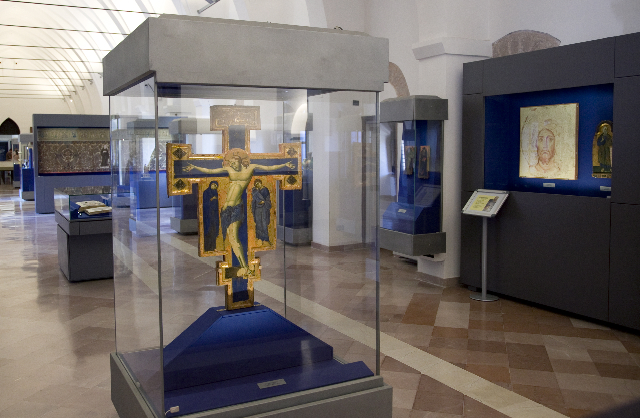Treasure Museum of the Basilica of St Francis
The Treasure museum of the basilica of Saint Francis contains a collection of sacred art that is on display in two halls found on the northern side of the Cloister of Pope Sixtus IV which is part of the Sacro Convento in Assisi, Italy. The entrance is found on the second level of the renaissance cloister behind the apse of the Basilica of Saint Francis, which houses the remains of St. Francis of Assisi. Since 1986 the Museum has also displayed a collection of works donated to the Conventual Franciscan Friars by the Secular Franciscan and American art critic, Frederick Mason Perkins, who died in Assisi in October 1955.
St. Francis by Zurbaran Spiral Notebook. Buy it HERE

Two years after the death of San Francisco, in March 1228, Pope Gregory IX became a promoter of the construction of a church-sepulcher dedicated to him. On July 17, 1228, immediately after the canonization of Francis, the Pontiff laid the first stone of the sepulchral church, entrusting Brother Elias with the direction of the works. On May 25, 1230 the Basilica finally welcomed the mortal remains of San Francisco, and in May 1253 it was solemnly consecrated by Innocent IV. In 1754, Benedict XIV elevated it to the category of Patriarchal Basilica and Papal Chapel. With motu proprio of August 8, 1969, Pope Paul VI has reorganized his legal status, directly dependent on the Holy See, instituting a Cardinal as his Legacy for her.
The realization of the Basilica was commissioned to comacino masters, adopting in the architectural the prototype of the sepulcher of Christ in Jerusalem: a church built around the cell that contains the relics of the Saint. In 1230, the year in which the Romanesque construction of the lower Basilica was completed, Francisco's body was placed in a pit under the main altar. In 1236 the upper Basilica was completed, built in Gothic style. Three years later the bell tower was finished with cusp, Romanesque-Gothic style (the cusp was eliminated in 1518). The consecration of the altars of the two churches by Innocent IV dates back to 1253. Next, modifications were made with the construction of the side chapels in the lower Basilica (1290) and new sacristies were built (1341).
In 1445, local teachers built a stone atrium to protect the portal of the lower church. In 1604 the structures of the sacristies were modified and a secret sacristy was made at the base of the bell tower, to keep in it the relics and the treasure. Fray Elías de Cortona, companion and vicar of St. Francis, is generally considered the creator of the Assisi basilical complex. In this structure the gothic lines of matrix predominantly French are intermingled with the Romanesque lines, thus shaping an architectural masterpiece, unique in its kind.
The interior is decorated with the most extensive surface of frescoes that exists, offering the visitor a concert of colors of the greatest painters of the Florentine, Roman, Sienna and Umbra schools of the 13th and 14th centuries in Italy, impossible to find elsewhere: Cimabue, Giotto, Lorenzetti, Simone Martini. It is here that the new Italian figurative language took shape, "which changed the art of painting from Greek to Latin, and led to the modern" (C. Cennini). A collection of stained glass windows from the same period, made by German, French and Italian masters, gives a European air to the artistic celebration of the Saint.





Comments
Post a Comment